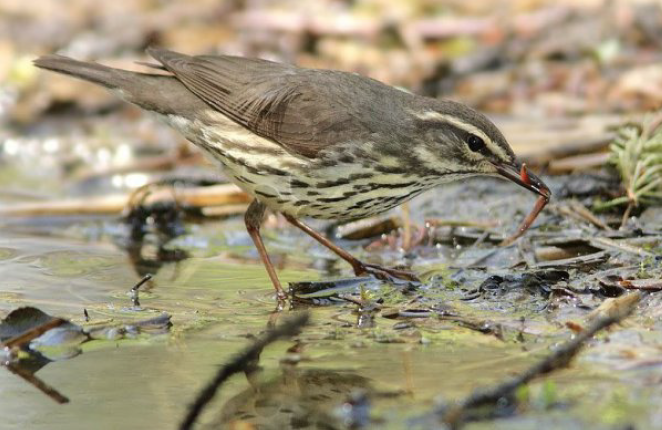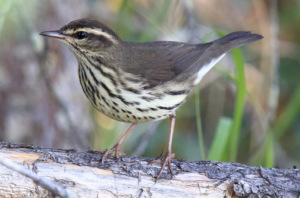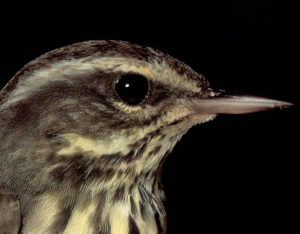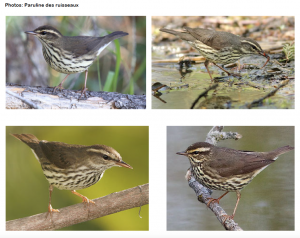This morning, Martin Picard of Développement ornithologique Argenteuil (DOA) unveiled Ruisseau Jackson Protected Natural Area’s (RJANP) emblematic bird following the popular vote held last summer. The winner (with 57% of the votes) was announced at the municipality of Morin-Heights’ Chalet Bellevue and is known as the Northern waterthrush!
Three bird species had been identified as possible emblematic birds for our organization. The finalists were:
- Northern waterthrush (Paruline des ruisseaux) = 57%
- Veery (Grive fauve) = 24%
- Red-eyed vireo (Viréo aux yeux rouges) = 19%
The northern waterthrush, veery and red-eyed vireo all have very interesting biological, behavioural and physical characteristics. They stood out from many other species in the area, even though they are very discreet.
The Northern Waterthrush is Unique!
This specie is often seen in the Ruisseau Jackson area and is easily identified by its songs. The small insectivore was observed within the first hour of the 2018 RuisseauBlitz amongst 51 other birds.
The Parkesia noveboracensis as we call him affectionally is underestimated in illustrating the importance of nature conservation. The bird inhabits fragile environments like those surrounding Ruisseau Jackson: mature woods, thick wooded areas and forested wetlands. Sadly, these areas are rapidly disappearing, and RJANP’s mission is to protect them. It’s no surprise then that the watershed is critical for the survival of so many bird species. Parkesia noveboracensis is a migratory specie, so we don’t see him in winter. As with the majority of forest species, our emblematic bird does not have vibrant colours. Its habitats are quite dusky, so its dull colours are a perfect camouflage.
More on Ruisseau Jackson’s Emblematic Bird
(Source: Audubon.org)
Conservation status: Could be vulnerable to loss of habitat, especially on wintering grounds, but surveys suggest that numbers are currently stable.
Habitat: Swampy or wet woods, streamsides, lake shores; in migration, also thickets. Breeds mostly in coniferous forests with standing or sluggish water, as found in shrubby bogs and edges of northern lakes, less often along swift streams. In migration, may appear in any habitat; more frequent in thickets along edges of water. In winter in tropics, often in coastal mangrove swamps.
The Northern Waterthrush is likely to be found around bogs and streams inside the forest. Often shy and hard to approach, it draws attention with its odd “teetering” behavior — bobbing the rear half of its body up and down constantly as it walks — and with its loud metallic callnote. It has a wide distribution in both summer (Alaska to New Jersey) and winter (Florida to South America).
Feeding behaviour: Walks on ground and wades in shallow water. Often forages on half-submerged logs. Uncovers prey by tossing aside dead and soggy leaves found in rock crevices. Defends winter feeding territories against other waterthrushes.
Nesting: Males sing throughout the breeding season, not ceasing after pair formation; song apparently serves to defend territory. Sometimes sings in flight. Nest site is usually in a small hollow in a moss-covered stump, under a jutting bank, or 0-2′ above the ground in roots of uprooted tree, typically very near water. Nest is in shape of open cup, often well hidden among ferns. Constructed by female of leaf skeletons, sphagnum moss, pine needles, twigs, inner bark, and lined with soft material such as red moss filaments.
Songs and calls: Chee-chee-chee, chip-chip-chip-chew-chew-chew!
Paruline des ruisseaux (Northern Waterthrush)
Audio Player




